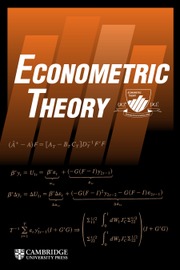Article contents
MODEL AVERAGING FOR TREATMENT EFFECT ESTIMATION WITH HETEROGENEITY AND HETEROSKEDASTICITY
Published online by Cambridge University Press: 24 June 2025
Abstract
The primary focus of this article is to capture heterogeneous treatment effects measured by the conditional average treatment effect. A model averaging estimation scheme is proposed with multiple candidate linear regression models under heteroskedastic errors, and the properties of this scheme are explored analytically. First, it is shown that our proposal is asymptotically optimal in the sense of achieving the lowest possible squared error. Second, the convergence of the weights determined by our proposal is provided when at least one of the candidate models is correctly specified. Simulation results in comparison with several related existing methods favor our proposed method. The method is applied to a dataset from a labor skills training program.
Information
- Type
- ARTICLES
- Information
- Copyright
- © The Author(s), 2025. Published by Cambridge University Press
Footnotes
We thank the Editor (Professor Peter Phillips), the Co-Editor (Professor Michael Jansson), and three anonymous referees for constructive comments which led to great improvements of the article. This work was supported in part by the National Key Research and Development Program of China under Grant 2023YFA1008704. Wei acknowledges support from the Startup Foundation for Introducing Talent of NUIST (Grant No. 2024r013) and the Natural Science Foundation of Jiangsu Province (Grant No. BK20240690). Yang’s research was supported by the National Social Science Foundation of China (Grant Nos. 24BTJ069 and 24BTJ070) and the National Statistical Scientific Research Center Projects 2024LY009. Chen acknowledges support from National Natural Science Foundation of China (NNSFC) (Grant No. 12161072). Zhang acknowledges support from NNSFC (Grant Nos. 72525001 and 72495124) and Beijing Natural Science Foundation (Z240004).
References
REFERENCES
- 2
- Cited by

